Col. Gregg F. Martin walked onto an airfield at a sprawling U.S. Army base north of Baghdad on Feb. 3 with the headquarters company of his command, the 130th Engineer Brigade. The soldiers climbed into a C-17 cargo plane that spiraled upward to gain altitude above the base, minimizing its exposure to enemy fire, before heading for Germany. That ended Martin’s year of service in the combat zone of Iraq and the wildest episode yet of an extraordinary career.
Col. Martin led the U.S. Army’s construction mission in the Iraq campaign with intelligence, energy and courage. As the fighting ebbed, he quickly helped set the stage for reconstruction. He brought an innovative style of flexible organization and management as well as personal inspiration to his command. His responsibilities expanded drastically to include coordination of more than 15,000 engineer-soldiers and their shiploads of equipment from dozens of units called up and thrown into the fight.
"Gregg Martin did a superb job," says his wartime commander, Lt. Gen. William S. Wallace, in a March 15 summation of Martin’s performance. Wallace led the Army’s V Corps, which planned and ran last spring’s ground campaign. Martin not only led the Corps’ engineer component but also served as Wallace’s chief engineer - the ranking engineer for V Corps’ war planning. "He is a great officer, a great engineer, a great soldier and a great individual," Wallace says.
“...a great officer, a great engineer, a great soldier and a great individual.”
— LT. GEN. WILLIAM S. WALLACE, COMMANDER, V CORPS
Martin’s skills and leadership helped engineers achieve their mission with swift efficiency in the best traditions of the U.S. military. His service represents an immense personal accomplishment and capitalization on decades of training and education that seem almost prescient to the needs of the campaign.
For his extraordinary service, and to honor the accomplishment of all the military engineers serving the nation, Engineering News-Record has chosen Col. Gregg F. Martin to receive its Award of Excellence for 2003.
Martin won ENR's top award for his masterful planning and execution of the engineer support for the U,S, Army's invasion of Iraq in 2003.
Credit: Great Projects Film Co., producer. Video by Tom Sawyer/ENR, with additional footage from Dept. of Defense sources.
During the war, Martin’s engineers built and repaired roads, bridges, airfields and bases, sometimes under fire and always at the most critical junctures. Then, as Baghdad was taken, Martin’s engineers immediately began civil reconstruction to ease unrest among the Iraqi people by addressing myriad infrastructure needs. Simultaneously, they turned their resources to base construction, road building, enemy ordnance demolition and force protection for both the coalition troops and the fledgling Iraqi police and the country’s civil defense forces.
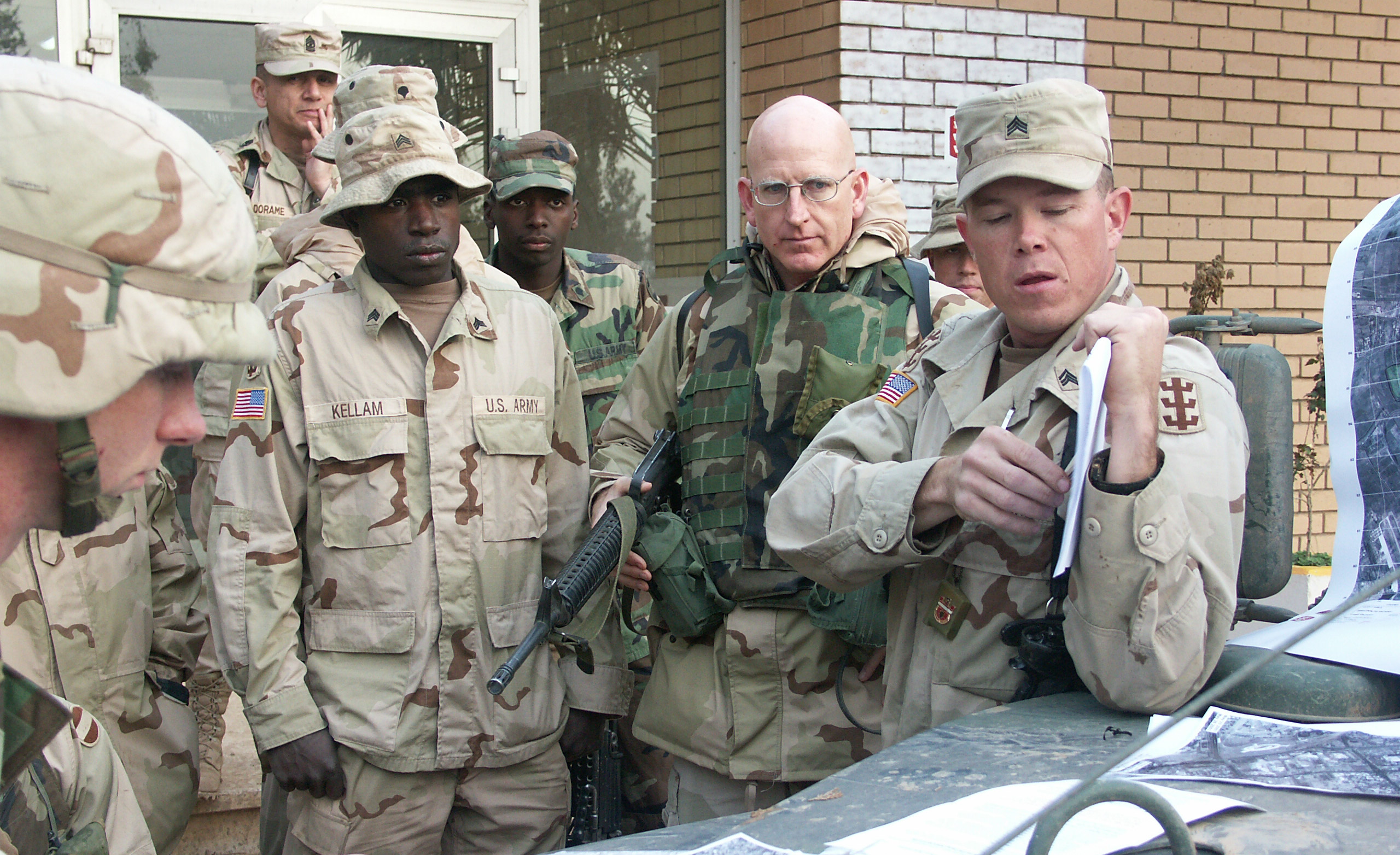
Security gets strict attention in pre-convoy briefing for trip from Balad to Baghdad on Jan. 25.
Martin’s role in the campaign began when he reported in Germany as the new commander of the 130th in June 2002. The 47-year-old soldier was immediately swept up in what became 10 months of top-secret preparation for invasion.
Poring over terrain maps, satellite imagery and intelligence data, planners scripted various alternatives for the assault. "The engineers are a key player in developing the operational scheme of maneuver," Martin says. "The main commander will lay out that this is the mission. Then, the planners...including engineers, come up with different courses of action and critique them. The engineers have a heavy vote."
There were three basic routes to Baghdad: go straight up the middle between the Tigris and Euphrates rivers; or go westward across the desert and then turn north for Baghdad; or go even further around and come back at the city from the north and west. The second alternative was chosen.
"The way we ended up going had less population, fewer canals and fewer river crossings. The bad news was that the road network was very, very weak. The biggest advantage was that we went around most of their defenses," Martin says. As the force advanced, it made several thrusts to appear to be turning for the middle, but those moves were intended to fool the enemy. "We just went around most of them," says Martin.
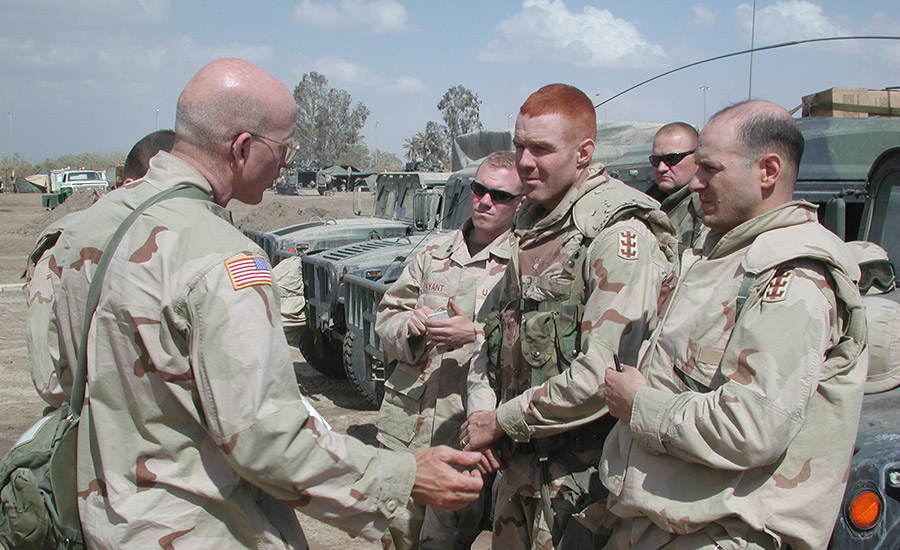
Martin confers with Capt. Nicholas Nazarko, center, who was Martin’s construction manager throughout the campaign
As engineering tasks were identified during planning, they were resourced by tapping regular engineer units from all over the army and by calling up troops from the National Guard and Reserves. An invasion force was mobilized, deployed to the gulf region and staged for action. A huge multicamp build-up began to rise in the desert of Kuwait as advance elements of Martin’s engineers helped to create an infrastructure to support and organize the invasion.
On March 21, 2003, the assault was launched. Martin led the ever-expanding mass of engineers into the fight in a campaign that today is being used to rewrite U.S. military doctrine. By the time the tasks began to shift to stabilization and recovery, Martin had six colonels and their units working under him. All were commanders of engineer groups performing tasks across Iraq that ranged from restoring civil services in Baghdad to building bases and repairing bridges for regional governments.
During the fight Martin’s engineers, or "Sappers," as they are known, "were probably the most versatile force that we had available during the fight," Wallace says. After the attack, Martin redirected the engineering force with characteristic zeal and effectiveness to help stabilize the country. "The combat tasks were what we prepared for, but the stability and support tasks, the nation-building tasks, became the center of gravity of our engineer effort. The control of all of that was maintained very expertly by Gregg Martin," Wallace adds.

Col. Martin traveled almost constantly with a core group of soldiers from the 130 Engineer Brigade's Headquarters Company during the 2003 invasion to inspect and encourage widely scattered units attached to his command.
Martin’s positive attitude and endurance are the qualities people talk about most. "One thing anybody who has ever met Gregg Martin remembers about him is the enormous energy he has," says Wallace. "And it is not just personal energy, it is energy that becomes contagious; contagious within the organization he is in command of, but also contagious across the entire formation."
From his first posting after graduation from West Point in 1979 and subsequent training in the Army’s Engineer and Ranger schools, Martin has demonstrated the qualities that made him an outstanding leader in the Iraq campaign. In raising him, his parents had emphasized education and public service. His late father, Donald Martin, a Navy veteran from World War II who went to college on the G.I. bill and earned a master’s degree in education, worked with public agencies and served local government in his community. His mother Patricia earned her own degree after her five children were no longer small and became a guidance counselor. Public service "wasn’t something they talked about, it was something they lived," Martin says.
An early Army evaluation of Martin lays out his key qualities: "Extremely knowledgeable in all areas of engineering and able to transfer that knowledge to those under his supervision...very articulate and open in expressing his opinion and enthusiastically carries out whatever decision is made...most physically fit individual in the company...a leader that continuously challenges and motivates the younger soldiers...Martin is going to be an outstanding officer whose career should be carefully managed to insure maximum exposure to soldiers. Recommend civilian schooling."
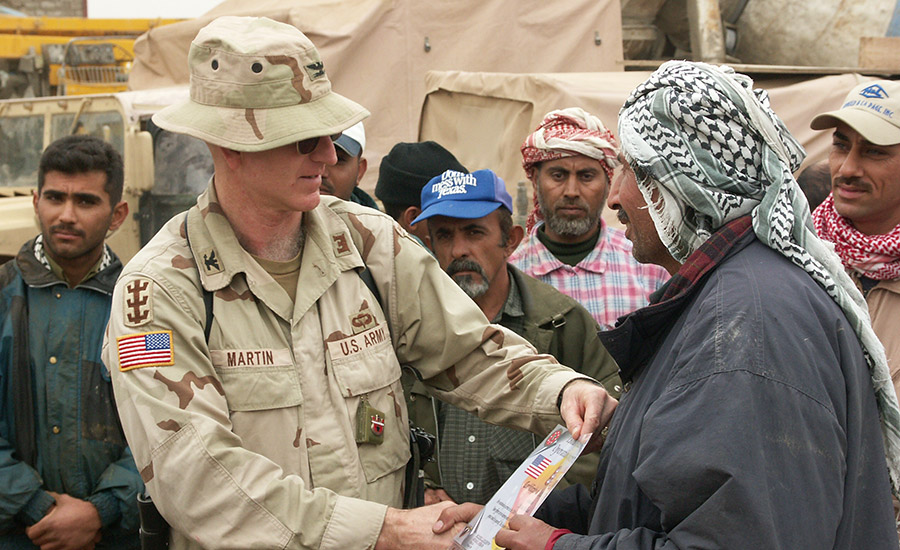
Martin was often reaching out to the Iraqi people — especially, to contractors and material suppliers who braved attacks to support U.S. Army construction work.
Martin eventually got plenty of civilian schooling, although his military career had a false start. He originally planned to join a pair of highly regarded uncles in the U.S. Coast Guard. He was all but accepted to its academy after high school but failed a vision exam. Deeply disappointed, he enrolled in the University of Maine, thinking of going into forestry. Instead, he discovered the Reserve Officers Training Corps, fell into its program and applied to all the service academies the following year. He was accepted at West Point and his military career was off and running.
After his first command in Germany, the Army sponsored Martin to a master’s program at MIT in 1986. He was an extremely motivated student and piled on extra courses that interested him. "I tried to keep related to military engineering," he says. He emerged 21 months later with two master’s degrees, one in civil engineering and one in technology and policy, and all the course work completed for his next campaign - a Ph.D. He received a doctorate in engineering management and public policy in 1992.
Martin’s career took him back to school several times, adding two more master’s degrees. "The commanders who come out of the field to go to school tend to do extremely well," he says.
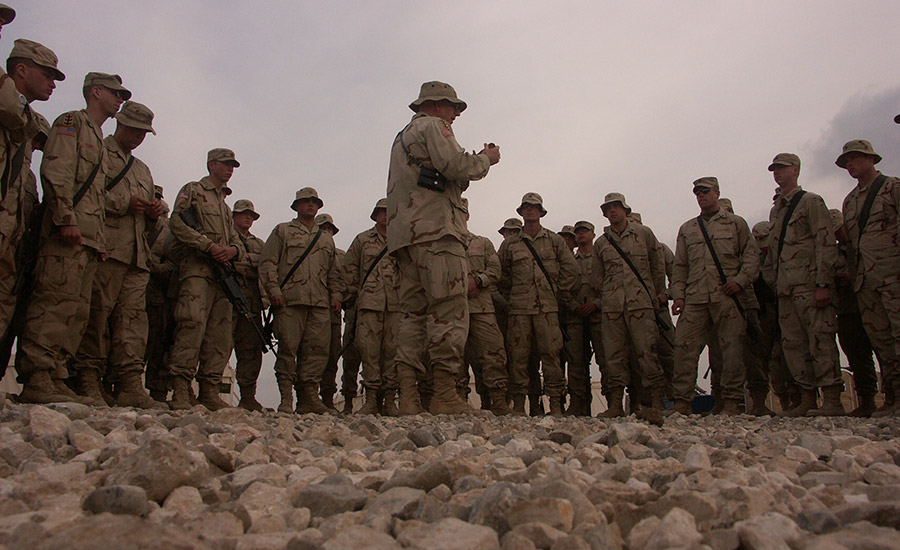
During his encounters with soldiers in the field Martin offered praise and admiration for their mission-focused efforts, and then he frequently challenged them all to a run.
The field experience was his foundation. Martin served in Germany as a lieutenant in the 94th Engineer Battalion, a unit that backs up combat operations with heavy equipment, and later as a company commander with the 79th Engineer Battalion. Martin credits that period with helping prepare him for Iraq. It included three heavy doses of intense construction under extreme conditions rebuilding a vital NATO training range at Grafenwoehr, Germany.
For each of three years, one of the impact areas was shut down for construction while the surrounding range continued in a training uproar. "You actually had tanks and Bradleys on the move all around, artillery shooting at all hours, attack aircraft screaming in at treetop level. It was a lot of fireworks," Martin recalls.
"It was a monumental effort," says Lt. Col. Paul Grosskruger, who also worked on the project as a junior project engineer and platoon leader, and went on to command the 94th Engineer Battalion under Martin in Iraq. During last spring’s fight, Martin used the 94th as one of the most aggressively deployed combat heavy battalions in history. "I don’t think any combat heavy was ever deployed as far forward as the 94th engineers," says Lt. Col. Mark Holt, Martin’s deputy commander during the assault. One of the 94th’s companies took its road management and road construction equipment "right on the heels of the calvary, even in front of the infantry," Holt says.
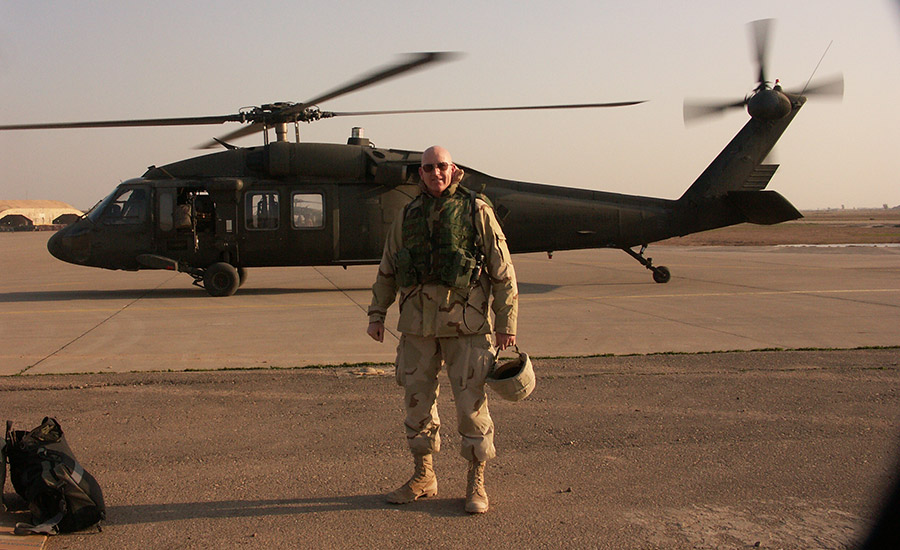
Setting off for another round of inspections via Blackhawk.
"There was concern for the trafficability of the road in the south and the only way to handle it was to get scrapers, dozers, compaction equipment, road graders and water distributors out there in the front," says Holt.
Holt says Martin’s use of the 94th and other engineer battalions, whose resources were frequently broken down, task-organized and dispatched on rapid missions all over the battlefield, was typical of his aggressive and innovative approach to the campaign.
At Tellil Air Base, near An Nasiriyah, one of the earliest objectives of the war, engineers, including Martin and a lightly armed band that was his rolling tactical command post, charged in to start runway clearing work while the infantry was still in the fight. "Those guys went right behind the gunslingers," Holt says. "They caught the Iraqis off guard, secured the base and then pushed a platoon up to the bridge crossing of the Euphrates." The engineers swiftly repaired the bridge to allow a major passage of troops and the execution of the northern prong of the attack toward Baghdad. "Having combat heavies that far forward and integrated that deeply...is unheard of," Holt says.
Holt’s job, as deputy commander, included managing the reception and resupply of engineer units pouring into the theater, and then shoving them to
the front. The attack actually had been launched early when it was perceived the Iraqis were off guard, so many elements were still coming up as the army raced in. "Martin was moving forward. Every time an engineering unit became available we were feeding it north." Holt says.
"The Sappers were going to be part of the fight and frequently they were going to be the lead element," says Wallace. "It made no difference whether it was really fighting or if it had something to do with building a road, providing basic infrastructure to the Iraqi people, building a school, painting something, or picking up garbage, the engineers attacked it with all their energy."
Wallace tapped Martin as soon as Baghdad was taken to deploy engineer missions to relieve Iraqi suffering. Within a day, he had Task Force Neighborhood up and running, raiding the most run-down corners of the city with gangs of engineers and equipment, teamed up with medics and dentists and other services. They organized and hired local citizens to collect garbage and repair community facilities such as soccer fields and schools. Again, field experience was Martin’s foundation. Deployments in Honduras, where he had organized similar expeditions a dozen years before, served as the model.
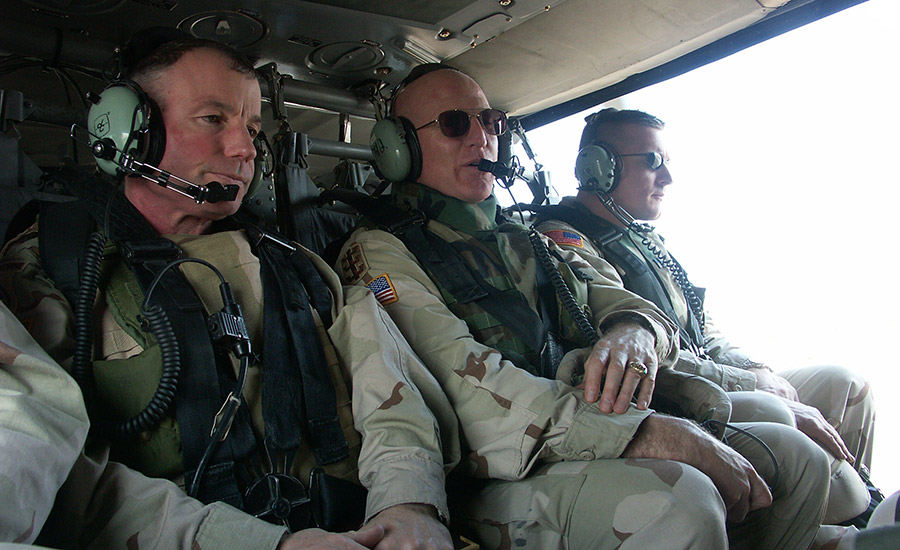
Martin, center, with Brigader General Merdith (Bo) Temple (left), and Major General Walter Wodjakowski, deputy commanding general of the U.S. Army V Corps, which was in charge of the invasion, on a Blackhawk run to push crews for faster expansion and upgrade of the Abu Garaib prison west of Baghdad, a few weeks before the prison became notorious for prisoner abuse.
Capt. Nicholas Nazarko, who was Martin’s construction manager throughout the campaign, says engineering officers at Fort Leonard Wood in Missouri are re-examining the rules on how to use combat engineers based on the war, mainly because engineers jumped on so many unusual and unprecedented missions. If V Corps had a mission that was "obviously not a field artillery mission, obviously not an infantry mission, obviously not an armored mission, they would throw it at the engineers for us to figure out," Nazarko says. "We were the catch-all guys. We had to get over the fact that we were doing non-doctrinal missions."
One good example was the use of the engineers to launch the monumental effort to collect and dispose of Iraqi munitions stockpiled all over the country. The most unusual job of that assignment was called Task Force Rocketeer. The engineers were asked to defuel and destroy 67 unstable SA-2 medium range missiles abandoned by Iraqi defenders. At least three already had exploded where they sat from high temperatures and looting of components. Thirty-three were discovered in Baghdad neighborhoods, loaded, armed and ready to fire.
The detonation risk was so great they could not be moved until civilian experts arrived to train and equip Martin’s crane operators and bridge and construction units to remove the toxic, unstable fuel. Only one accident was reported. A drum of chemicals burst and rocketed into the air, releasing a red cloud of toxic, explosive fuel. Fortunately no injuries resulted.
Another good example of Martin’s creativity was Nazarko’s assignment to follow the fighters and forage for construction materials, and, even more importantly, local contractors who were willing to work. "We were really pushing getting local contractors, even on the attack," says Martin.
"It was Col. Martin’s idea," Nazarko says. "I had a team of 12 guys, enough people to move around on my own." They took a construction management organization that typically would work in the rear (planning base camps and facilities from maps and imagery) and ran it forward to support troop construction.
The approach was an innovative response to evolving conditions, as reality diverged from the war plan and troops took on construction work that they had expected civilian contractors to handle. "We always assumed civilian contractors would be right behind us," Nazarko says. "It just didn’t work out that way."
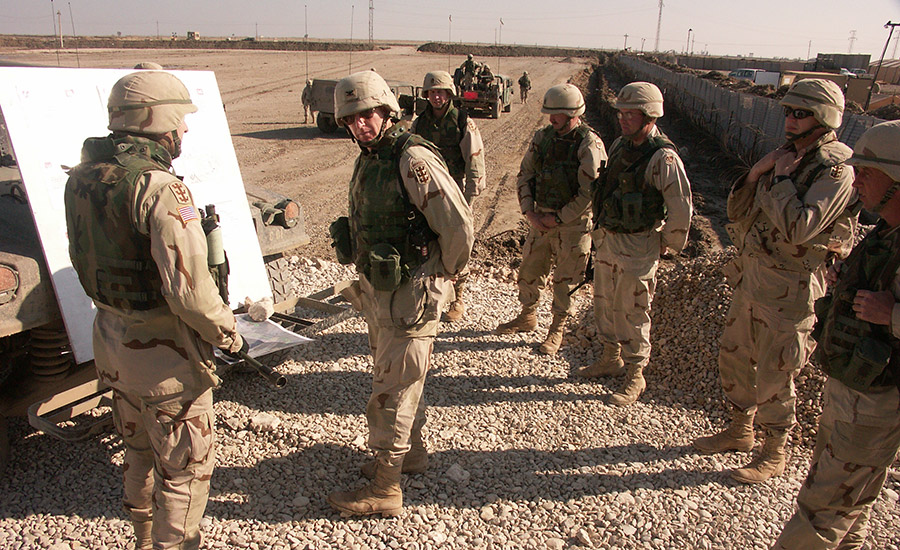
Martin's engineers were tasked with all kinds of civil construction, including upgrading and completing highway projects, some of which had floundered for generations.
And as fast as Martin tasked engineers to aid the maneuver and logistics forces, he also pulled them off and pushed them on again to the point of greater need. Nothing sat idle. That was the case for Martin himself, too. "He was on the ground with the troops who were doing the work. He wasn’t the guy in the back with the map and the communications. In many cases, he was with the lead element of the brigade," Nazarko says.
"I think that has changed the way we will look at training," Nazarko says. "The next time we train in Eastern Europe, we’ll send units to different countries and then try to operate and command and control the brigade. We need long-range communications and systems to see what the sub-units are doing, even if they are really far away."
Another of Martin’s wartime battalion commanders, Lt. Col. (Ret.) Scott Fehnel of the 864th, says part of the engineers’ "remarkable success" comes from Martin’s leadership style. He made sure his commanders always understood the main commander’s intent and built a personal rapport that proved invaluable once the army stretched out hundreds of miles across Iraq. For example, Fehnel frequently found himself "with 400 pieces of construction equipment and 40 low-boys, and my boss is telling me to move with all speed," he recalls with a laugh. He accomplished the task by rationing the low-boy trailers, hauling around the clock and leapfrogging equipment from mission to mission—fully confident he understood Martin’s priorities.
Fehnel’s confidence started with his first meeting with Martin at Camp Virginia, Kuwait. "When we arrived in the beginning of March, there was this bald guy running around in civilian clothes," Fehnel says. In the days before the invasion, Martin scouted the Kuwait/Iraq border defenses wearing a flack vest, red checkered shirt and jeans, trying to pass as a civilian.
Fehnel finally cornered his nonstop commander in the 130th’s Tactical Operations Center–an elaborate, modular tent humming with activity as officers prepared battle plans and assessed intelligence data. Field reports crackled over the radios. Maps were plotted and situation reports were updated on banks of secure computers wired to communications equipment by snakes of scarlet ethernet cable.
"We sat down and talked, right in the middle of the TOC," Fehnel says. "There was this whirlwind of activity and I thought it would be, ‘Here’s the tactical situation of maneuver’...but he asked me about my family and told me about his wife and kids," Fehnel says. They talked for an hour and Fehnel says it was the best briefing he could have had to prepare for the war because by the end of it, he understood his commander, his drive and intent and he knew what Martin would want him to do without orders.
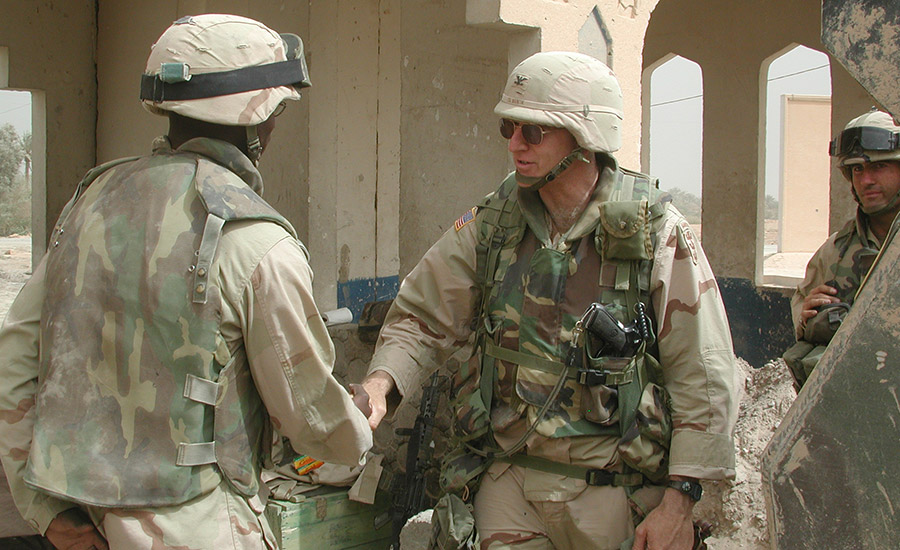
On the battlefield, Martin always braked for engineers to offer encouragement and to thank them for their work.
Martin told Fehnel about his wife Maggie and their sons Patrick, Phillip and Conor. They talked about the Army life, the importance of family and the moves and career choices they had made.
"I choose to do this. I’m living the dream," Martin says of his career and service in the Iraq campaign as he awaits word on his next posting, which should arrive in mid-year. He is proud of his engineers’ performance and calls the experience "the ultimate" for an Army career. He also believes deeply in the importance of the mission.
"Iraq is the main effort for the nation," Martin says. "We’ve just got to surge and make it happen. The Iraqis want it to happen. They want to integrate with the world community and its business, commerce and education. There are obviously some who are not so enamored with this, and that is why we have to continue to press the fight.”
His advice to the soldiers and the nation is vintage Martin: "Don’t wimp out. Don’t get tired. Stay focused to the end. Despite the dangers, you’ve got to step out, move out and get the job done."
Gregg F. Martin walked onto an airfield at a sprawling U.S. Army base north of Baghdad on Feb. 3 with the headquarters company of his command, the 130th Engineer Brigade. The soldiers climbed into a C-17 cargo plane that spiraled upward to gain altitude above the base, minimizing its exposure to enemy fire, before heading for Germany. That ended Martin’s year of service in the combat zone of Iraq and the wildest episode yet of an extraordinary career.



Post a comment to this article
Report Abusive Comment